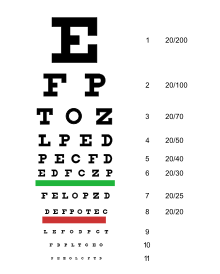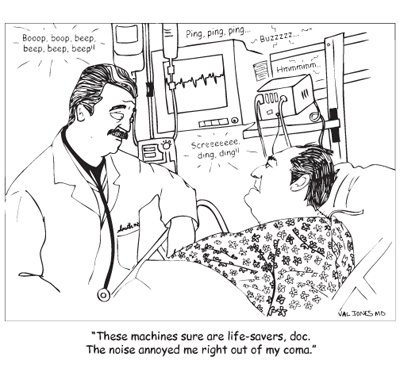December 20th, 2011 by Dr. Val Jones in Health Tips
No Comments »
 Most people assume that their eyes are healthy if their vision is stable, but this is not always the case. Eye doctors look for many different potential diseases and conditions during a comprehensive eye exam, and if you (or your children or loved ones) haven’t had one recently then maybe it’s time to make it a New Year’s resolution for 2012?
Most people assume that their eyes are healthy if their vision is stable, but this is not always the case. Eye doctors look for many different potential diseases and conditions during a comprehensive eye exam, and if you (or your children or loved ones) haven’t had one recently then maybe it’s time to make it a New Year’s resolution for 2012?
One CDC survey suggests that as many as 34.6% of adults over the age of 40 (with moderate to severe visual impairment) believe that they don’t need regular eye exams. This popular misconception may lead to missed diagnoses. Eye doctors look for signs of diabetes, high blood pressure, high cholesterol, glaucoma, multiple sclerosis, brain tumors, cataracts, macular degeneration, retinal tears, allergies and infections (among other things) each time they conduct a comprehensive eye exam. The exam offers a lot more than a simple vision check. And this is particularly important for children.
In a recent interview with the president of the American Optometric Association (AOA), Dr. Dori Carlson, I learned the surprising statistic that about 1 in 4 school age children have an undetected or undiagnosed vision problem. School vision screenings, while helpful, still miss more than 75% of these problems. And for those kids who are discovered to have a vision problem during a school screening, upwards of 40% receive no follow up after the diagnosis.
The eyes are more than a “window to the soul” but a window to general physical health. And the good news is that exams are relatively inexpensive and painless – so why not resolve to make them part of your yearly health maintenance routine, starting in 2012? Let’s make 2012 a year for healthy vision!
December 14th, 2011 by Dr. Val Jones in Expert Interviews, Health Policy, Research
No Comments »
It is estimated that as many as 10 million U.S. adults have ADHD (Attention-Deficit/Hyperactivity Disorder). A recent research study (publication-pending) suggests that the economic burden of ADHD on America could be as high as $250 billion annually. I attended a recent briefing on Capitol Hill and interviewed one of the study’s co-authors: Tufts economist, Dr. Peter Neumann as well as congressman (and psychologist) Tim Murphy about ADHD in America.
I learned from Dr. Neumann that cost these high cost estimates are most strongly influenced by reduced productivity in adult workers with ADHD rather than direct costs of treating children with the disorder. Productivity costs include absenteeism, and reduced work output due to difficulty focusing. Dr. Neumann explained that ADHD has many “spill over effects” in that it impacts the educational system, the justice system, the healthcare system, and our work environments. Please check out our interview video for the full story.
Congressman Tim Murphy is a clinical psychologist with three decades of experience in treating people with ADHD. He is also Co-chair of the Mental Health Caucus and GOP Doctors Caucus where he regularly works to raise awareness of healthcare accessibility needs. I had the chance to interview him also at the event.
I learned from Rep. Murphy that the costs of ADHD multiply when patients are untreated. Getting the correct diagnosis is critical, because impulsivity and problems with focusing are not always caused by ADHD. These symptoms can be caused by lead poisoning, damage to the limbic system of the brain, metabolic disorders, or even sleep apnea. Children who are inattentive should not be put on medications for ADHD without first confirming the diagnosis by ruling out other possible causes.
Rep. Murphy recommends a team approach to the management and treatment of ADHD and he believes that costs related to ADHD are escalating because some physicians are not managing children holistically, but resorting to prescribing medications without involving counselors and family directly. He sees lack of health insurance coverage for behavioral health services as a threat to comprehensive and effective ADHD treatment.
Please watch the video for the full interview with congressman Murphy.
*Please note that the panel event, and Better Health’s participation, was made possible by a grant from Shire Pharmaceuticals.
December 9th, 2011 by Dr. Val Jones in News, Patient Interviews
1 Comment »
 There aren’t too many grandmothers developing mobile health apps these days, but I met a charming one (Jill Campbell) at the mHealth Summit yesterday. Jill is a 60 year-old woman from Texas who has been actively concerned for the safety of herself and her daughter over the years.
There aren’t too many grandmothers developing mobile health apps these days, but I met a charming one (Jill Campbell) at the mHealth Summit yesterday. Jill is a 60 year-old woman from Texas who has been actively concerned for the safety of herself and her daughter over the years.
“My daughter took a self-defense class,” Jill explained, “And she was taught the ‘fight or flight’ response to escape harm. I’m 60 years old. I’m not good at fighting and not very fast at fleeing. So what’s my third option?” Jill created the WatchMe 911 app to provide the solution.
“I first started thinking about a personal alarm system before smart phones even existed. I saw that there were car alarms and house alarms, and wondered why there weren’t personal alarms. At the time I imagined that the personal alarm would go through an answering service system, but since smart phones were created, it can all be tied together in an app format.”
Jill demonstrated the WatchMe 911 app to me during our interview. It contains features such as a panic button that can be armed in advance. Two taps on the smart phone screen and a circle of friends and 9-1-1 are contacted immediately with your GPS location and an alert message. The panic button is a favorite for women who are concerned for their safety when walking late at night or in dimly lit parking lots or alleys. Read more »
November 21st, 2011 by Dr. Val Jones in Quackery Exposed, True Stories
1 Comment »

Photo Credit: Mark Crislip, M.D.
During a recent trip, I met a woman whose father had just passed away. When she discovered that I was a physician, she decided to tell me the sad story of the events leading up to his death. She gave me permission to share the story on my blog so long as I did not identify her or her family by name. For the purposes of the story, I’ll refer to the woman as Sue, and her father as Frank.
Frank was a healthy, robust man, descended from a long line of nonagenerians. Everyone assumed that he would live well into his 90’s – at least 30 more good years. One day Frank began having some leg pain, which he ignored as long as he could. Sue noticed him limping around a week later and decided to take him to see a physician. As it turned out, Frank had a deep venous thrombosis (or blood clot) in his leg, caused by a previously undiagnosed, mild genetic clotting disorder. The physicians treated him with heparin to prevent the clot from expanding, and prescribed coumadin to protect him from having the clot travel to his lungs – a condition (pulmonary embolism) that carries with it a high risk of death.
While researching his new medicines, Frank came upon an alternative medicine website. The site warned people against taking coumadin (stating that it was “a form of rat poison”) and offering herbal supplements instead. Frank decided to stop taking his coumadin, and purchased the alternative medicine from the website. Two weeks later he Read more »
November 13th, 2011 by Dr. Val Jones in News, Opinion, Quackery Exposed
12 Comments »
 I’ve been following the recent Delta airlines flu vaccine kerfuffle with interest and now amazement. After running in-flight infomercials by a notorious anti-vaccine group (NVIC), the American Academy of Pediatrics alerted Delta to the faux pas with a letter from president Robert W. Block, M.D. I had assumed that Delta would be grateful for the head’s up, and would immediately remove the infomercials. Instead, they chose to ignore the letter, denying that they saw any harm in associating themselves with anti-vaccine activists. Despite the warning, they will continue to run the ads through the month of November.
I’ve been following the recent Delta airlines flu vaccine kerfuffle with interest and now amazement. After running in-flight infomercials by a notorious anti-vaccine group (NVIC), the American Academy of Pediatrics alerted Delta to the faux pas with a letter from president Robert W. Block, M.D. I had assumed that Delta would be grateful for the head’s up, and would immediately remove the infomercials. Instead, they chose to ignore the letter, denying that they saw any harm in associating themselves with anti-vaccine activists. Despite the warning, they will continue to run the ads through the month of November.
Every year the influenza virus kills as many as 49,000 Americans and 500,000 individuals world-wide. According to the CDC, the best defense against these often preventable deaths is the influenza vaccine. Since viral spread is especially likely in closed quarters where air from infected individuals is recirculated (such as in an airplane) it is critical for extra precautions to be taken before and during air travel. In addition to yearly flu vaccination, the use of alcohol-based hand wipes, regular hand washing, covering one’s mouth during coughing, are recommended. Since the flu virus can live in droplets outside the body for up to 48 hours, door knobs, seat covers and tray tables can spread the virus from passengers on previous flights.
I don’t understand why Delta, Read more »
 Most people assume that their eyes are healthy if their vision is stable, but this is not always the case. Eye doctors look for many different potential diseases and conditions during a comprehensive eye exam, and if you (or your children or loved ones) haven’t had one recently then maybe it’s time to make it a New Year’s resolution for 2012?
Most people assume that their eyes are healthy if their vision is stable, but this is not always the case. Eye doctors look for many different potential diseases and conditions during a comprehensive eye exam, and if you (or your children or loved ones) haven’t had one recently then maybe it’s time to make it a New Year’s resolution for 2012?

 There aren’t too many grandmothers developing mobile health apps these days, but I met a charming one (Jill Campbell) at the
There aren’t too many grandmothers developing mobile health apps these days, but I met a charming one (Jill Campbell) at the 
 I’ve been following the recent
I’ve been following the recent 







